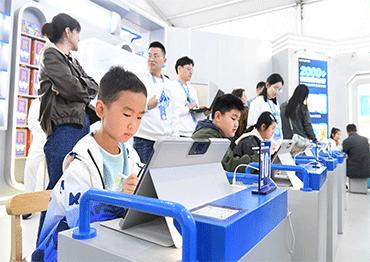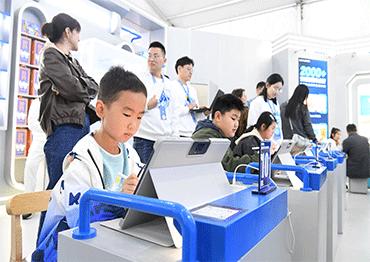“When homework piles high, and deadlines draw so nigh, who do we turn to, quick and wise? DeepSeek Chat – our saving prize!
Titled “DeepSeek to the Rescue,” this is from a poem written by the large language model using the prompt “students using DeepSeek to do homework.”
Zhang Siling, an eighth grader at Beijing No.18 Middle School, has used DeepSeek to help write a composition for her Chinese class. She typed in the question, and in seconds DeepSeek generated a nicely written article.
A cat-and-mouse game is happening between students and teachers in China’s primary and middle schools. Like Zhang, more students are relying on AI tools for their homework. As AI’s language capability is way beyond that of teenagers, they simplify the language and syntax to make it convincing. Teachers have to turn detective to trace AI use in the assignments.
China has pushed a new AI initiative in education. In March, Beijing education authorities mandated primary and secondary schools to provide AI courses from the autumn semester for at least eight hours. Children as young as 6 will learn how to engage with AI-powered tools.
A powerful helper for learning or a thief that steals children’s intelligence, the use of AI has sparked public debates just as the ethics of technology use has become a major concern for educators.
Before DeepSeek, Zhang Siling was already handy with AI tools such as Doubao, a ChatGPT-like conversational bot developed by TikTok owner ByteDance, and iFlytek Spark, an AI solution provider developed by iFlytek as an alternative to ChatGPT.
“Give me the solution to this math problem and explain it at my level as an eighth grader,” is an example instruction Zhang gives to a generative AI tool. While the previous tools she used remain in a “Q&A” phase, DeepSeek can give answers and present a thorough explanation of the problem-solving process. For her, DeepSeek is a better tutor than her parents and teachers.
According to a study conducted by China Children’s Daily, which surveyed 11,742 primary school students over 29 provinces and districts in China, 26.6 percent of students have used AI for homework help. More than 60 percent of interviewees used AI to solve problems, 40 percent used it to make presentations, and over 36 percent used AI to write compositions.
On social media there are many suggestions for students to better use DeepSeek to help them study.
For studying Chinese and English, DeepSeek can communicate with students in the same voice as characters in literary classics, such as Hamlet in Shakespeare’s Hamlet, Jean Valjean in Victor Hugo’s Les Misérables or Lin Daiyu in Cao Xueqin’s 18th-century classic Dream of the Red Chamber. It can weave new English vocabulary into a short article to help students better memorize the words and understand how to use them in speaking and writing.
When teaching the poetry of Li He, a poet from the Tang Dynasty (618-907), Zhang Junqi, a Chinese teacher at Beijing No.18 Middle School, uses AI to visualize the poet’s works.
Li He (790-816)’s poetry is characterized by its vivid imagery and idiosyncratic diction. Zhang Junqi used ByteDance’s Doubao to generate pictures based on Li’s poems and used the AI video generator Hailuo AI to generate videos. “I choose different AI tools based on the content I’m teaching and the effect I hope to create,” Zhang Junqi told NewsChina.
Schools across the country are making efforts to reform their curriculums to include AI education.
On February 19, 2025, China’s Ministry of Education announced a list of 184 primary and secondary schools in 31 provinces and municipalities selected to pilot AI education programs.
Primary schools will introduce AI concepts, while middle schools will teach students how to use AI in learning and daily life. High schools will focus on enhancing AI applications and innovation.
Smart education companies are accelerating AI-powered education expansion. Bai Jingfeng, technical director of TAL Education Group, China’s largest K-12 after-school tutoring service provider, is project chief of MathGPT, the first domestic AI tool designed to help students, teachers and professionals solve complex mathematical problems.
He told NewsChina that DeepSeek-R1 is like a graduate from a prestigious university who is both good at science and arts, and is skilled at logical reasoning, structured problem-solving and explaining complex concepts.
The next objective is to make DeepSeek-R1 grow from a college graduate to a mature teacher. This requires making it more compatible with the latest K-12 curriculum system to provide customized plans catering to the needs of different students, Bai said.
The AI self-study room is a new business model that Bai describes as “technology providing services.” In China’s major cities, AI self-study rooms are popular with primary and secondary school students. They provide a tablet computer for each cubicle, which handles the teaching and exercises for each student. AI supervisors track mistakes, compile errors and offer AI-generated learning plans for pupils in real time. According to a report by Jiupai News, by July 2024, there were already 50,000 AI self-study rooms in China, mainly targeting students aged 8 to 18.
Educators and parents are still concerned over the technology’s “double-edged-sword” effect on schoolchildren. Many fear students will use AI to cheat on assignments and that critical thinking ability will be hampered.
An experienced primary school teacher in Northeast China told NewsChina that, “In the past, less experienced teachers could teach students based on their teaching plans. But now students can learn knowledge through AI in advance – sometimes they even know more than teachers. AI has closed the information gap between students and teachers.”
Professor Yu Shengquan, executive director of the Advanced Innovation Center for Future Education, Beijing Normal University, stressed that as more students use AI-driven learning tools, teachers should not just impart knowledge but also skillfully use AI to help students learn and solve problems. “More importantly, teachers should serve as gatekeepers to guide students to use AI properly,” Yu told NewsChina.
He suggested educators design more open, practical and innovative assignments instead of giving repetitive and mechanical learning tasks. This will develop students’ critical thinking and creativity while using AI-powered learning tools.
During the two sessions on March 6, 2025, Liu Qingfeng, president of AI technology firm iFlytek, suggested innovating the exam system, including college entrance examinations. He proposed that 70 percent of exams would be based on the traditional system, with 30 percent based on open-book exams in which students would be evaluated on their innovation capability with the use of AI tools.
“Even though the exam-oriented education system would not be shaken up in the short term, the talent evaluation system will surely change with the rapid development of AI in the long run,” Yu told NewsChina.

 Old Version
Old Version
